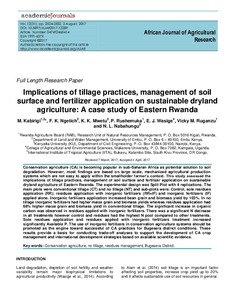| dc.contributor.author | Kabirigi, M. |
| dc.contributor.author | Ngetich, F.K. |
| dc.contributor.author | Mwetu, K.K. |
| dc.contributor.author | Rushemuka, P. |
| dc.contributor.author | Wasige, E.J. |
| dc.contributor.author | Ruganzu, V.M. |
| dc.contributor.author | Nabahungu, N.L. |
| dc.date.accessioned | 2019-12-04T11:11:18Z |
| dc.date.available | 2019-12-04T11:11:18Z |
| dc.date.issued | 2017-08 |
| dc.identifier.citation | Kabirigi, M., Ngetich, F.K., Mwetu, K.K., Rushemuka, P., Wasige, E.J., Ruganzu, V.M. & Nabahungu, N.L. (2017). Implications of tillage practices, management of soil surface and fertilizer application on sustainable dryland agriculture: a case study of Eastern Rwanda. African Journal of Agricultural Research, 12(31), 2524-2532. |
| dc.identifier.issn | 1991-637X |
| dc.identifier.uri | https://hdl.handle.net/20.500.12478/2400 |
| dc.description | Open Access Journal; Published online: 03 August 2017 |
| dc.description.abstract | Conservation agriculture (CA) is becoming popular in sub-Saharan Africa as potential solution to soil degradation. However, most findings are based on large scale, mechanized agricultural production systems which are not easy to apply within the smallholder farmer’s context. This study assessed the implications of tillage practices, management of soil surface and fertilizer application on sustainable dryland agriculture of Eastern Rwanda. The experimental design was Split Plot with 4 replications. The main plots were conventional tillage (CT) and no tillage (NT) and sub-plots were: Control, sole residues application (RR); residues application with inorganic fertilizers (RR+IF) and inorganic fertilizers (IF) applied alone. Inorganic fertilizers application increased bean grain and biomass yield by 103%. In no tillage inorganic fertilizers had higher maize grain and biomass yields whereas residues application had 68% higher maize grain and biomass yield in conventional tillage. The significant increase in organic
carbon was observed in residues applied with inorganic fertilizers. There was a significant N decrease in all treatments however control and residues had the highest N pool compared to other treatments. Sole residues application and residues applied with inorganic fertilizers treatment increased significantly Available P. The use of inorganic fertilizers in conservation agriculture systems should be promoted as the engine toward successful of CA practices for Bugesera district conditions. These results provide a basis for conducting trade-off analyses to support the development of CA crop management and international development strategies based on available scientific evidence. |
| dc.format.extent | 2524-2532 |
| dc.language.iso | en |
| dc.subject | Conservation Agriculture |
| dc.subject | No Tillage |
| dc.subject | Fertilizer Application |
| dc.subject | Soil Fertility |
| dc.subject | Residues Management |
| dc.subject | Bugesera District |
| dc.title | Implications of tillage practices, management of soil surface and fertilizer application on sustainable dryland agriculture: a case study of Eastern Rwanda |
| dc.type | Journal Article |
| dc.description.version | Peer Review |
| cg.contributor.crp | Roots, Tubers and Bananas |
| cg.contributor.affiliation | Rwanda Agriculture Board |
| cg.contributor.affiliation | University of Embu |
| cg.contributor.affiliation | Kenyatta University |
| cg.contributor.affiliation | Makerere University |
| cg.contributor.affiliation | International Institute of Tropical Agriculture |
| cg.coverage.region | Africa |
| cg.coverage.region | Central Africa |
| cg.coverage.country | Rwanda |
| cg.authorship.types | CGIAR and developing country institute |
| cg.iitasubject | Soil Fertility |
| cg.journal | African Journal of Agricultural Research |
| cg.howpublished | Formally Published |
| cg.accessibilitystatus | Open Access |
| local.dspaceid | 92358 |
| cg.targetaudience | Scientists |
| cg.identifier.doi | http://dx.doi.org/10.5897/ajar2017.12289 |

